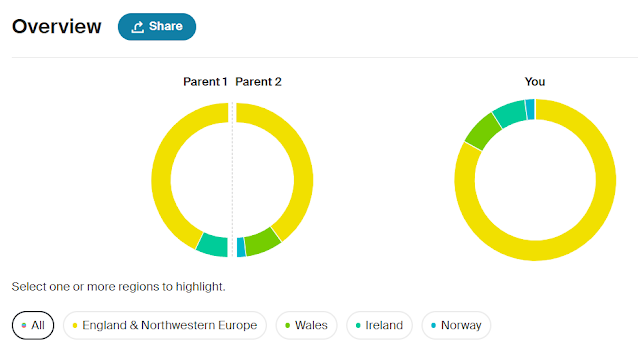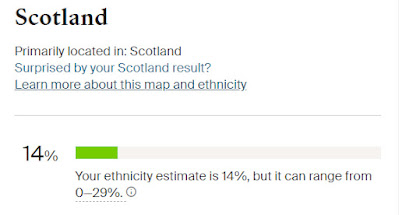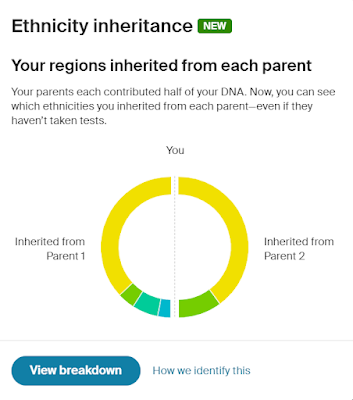I wrote about AncestryDNA's new SideView technology and the new ethnicity inheritance tool earlier this week. My results for my parents weren't yet available when I wrote the post and I thought it would be interesting to do a three-way comparison.
Ethnicity estimates
Debbie's dad
My dad's ancestry within the last few hundred years is all English apart from one maternal great-great- grandfather who is from Scotland. His paternal side is from Devon, Bristol and Gloucestershire. His maternal side is from Essex, Hertfordshire, Oxfordshire and London. Here is his updated ethnicity estimate.
The ranges are:
- England and Northwestern Europe 49% to 69%
- Wales 2% to 28%
- Scotland 0% to 30%
- Sweden and Denmark 0% to 16%
- Norway 0% to 15%.
The ranges can be found by clicking on the country names.
Debbie's mum
My mum's ancestry in the last few hundred years is all from England apart from one paternal great-great-grandmother from Ireland. Her paternal ancestry is from Hampshire (via London), Somerset and Ireland. She has an unknown paternal great-grandfather who is probably from Oxfordshire. Her maternal ancestry is from Hertfordshire, London, Hampshire, Berkshire, Bedfordshire, Buckinghamshire, Gloucestershire and Wiltshire. Here is her updated ethnicity estimate.
The ranges are:
- England and Northwestern Europe 70% to 100%
- Wales 0% to 17%
- Ireland 0% to 17%
- Norway 0% to 5%.
Debbie
Here is my updated ethnicity estimate.
- England and Northwestern Europe 65% to 99%
- Scotland 0% to 29%
- Wales 0% to 18%
- Ireland 0% to 9%
I am disregarding Norway, Sweden and Denmark in the results for my parents as noise. The reference population labelled as Wales actually stretches into North Devon, North Somerset, Bristol, Gloucestershire and Herefordshire so this may be a real representation of my dad's paternal ancestry from Devon, Bristol and Gloucestershire and my mum's maternal ancestry from Gloucestershire. There was a big migration from North Devon to South Wales in the 1800s with people moving to Wales to work in the copper and coal mines so many people from South Wales have Devon ancestry which may account for the overlap. The Scotland component is over-represented in many people at AncestryDNA and this reference population probably should have been labelled as Scotland, Ireland and England.
The genetic communities (also known as regions) are uncannily accurate. It's interesting to note how I get Gloucestershire, Wiltshire and Oxfordshire as a region despite the fact that neither of my parents has this region. This can easily explained by the fact that both of my parents have ancestry from both Gloucestershire and Oxfordshire so I actually get a double dose of DNA from these counties.
Ethnicity inheritance overview
Debbie's dad
This is the ethnicity inheritance overview and detailed comparison for my dad. If the Welsh component represents my dad's paternal ancestry from Devon, Bristol and Gloucestershire then Parent 1 is his dad. However, my dad's Scottish ancestry is on his mother's side yet the Scottish percentages appear in both parents but are much higher for Parent 1 than Parent 2. I therefore do not feel confident in assigning parental sides to these results.
Debbie's mumThis is the ethnicity inheritance overview and detailed comparison for my mum. Ireland only appears in Parent 1 and Wales only appears in Parent 2 so I am assuming that Parent 1 is her father and Parent 2 is her mother.
DebbieHere is my ethnicity inheritance overview and detailed comparison. The Scotland component is the odd one out here as it appears in both parents whereas it is only reported in my dad's results. Ireland only appears in Parent 1. I had originally assumed therefore that Parent 1 is my mum. However, the absence of Wales on my dad's side is surprising given that he had a much higher percentage of the Welsh component than my mum so it's quite possible that Parent 1 and Parent 2 are the other way round instead.
Conclusion
SideView is an innovative new technology from AncestryDNA and I remain excited by the possibilities it has opened up. While the "ethnicity" estimates are still a work in progress they are a huge improvement compared to the early days of autosomal DNA testing. When I received
my first biogeographical ancestry report from 23andMe back in 2010 they were only able to tell me that I was 100% European. We are now getting much more granularity within Europe, even if the country-level assignments, especially with the low percentages, are not very accurate. We can expect the results to improve over time. AncestryDNA regularly add new regions and provide updated ethnicity estimates every year. We can probably expect a further update this summer or in the autumn.
The
genetic communities are worked out in a different way and are based not on reference populations but on large segments of DNA shared in genetic networks. They are reflective of our recent ancestry within the last 200-300 years. They are remarkably accurate and for most people generally correspond with their known ancestry. Another possible application for the SideView technology would be to assign genetic communities to parental sides though, as in my case, it may be that some communities would need to be assigned to both sides. We have much to look forward to this year!














